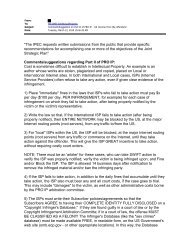We Energies Coal Combustion Products ... - The White House
We Energies Coal Combustion Products ... - The White House
We Energies Coal Combustion Products ... - The White House
Create successful ePaper yourself
Turn your PDF publications into a flip-book with our unique Google optimized e-Paper software.
alumina in the pozzolan may also react with calcium hydroxide and other<br />
components in the mixture to form similar products.<br />
High-calcium fly ash is both cementitious and pozzolanic and has selfhardening<br />
properties in the presence of moisture. <strong>The</strong> reaction products<br />
include ettringite, monosulphoaluminate and C-S-H. <strong>The</strong>se products are also<br />
formed when cement reacts with water and causes hardening in the cementwater<br />
mixture.<br />
<strong>The</strong> rate of formation of C-S-H in the fly ash-water mixture is normally<br />
slower than that in a cement-water mixture. Because of this, at ages greater<br />
than 90 days, fly ash-cement-water continues to gain strength; while the<br />
cement-water pastes do not show as significant a gain in strength. However,<br />
this hydration behavior of C 3 A and C 2 S in fly ash is the same as that in<br />
cement. Low calcium fly ash has very little or no cementing properties alone,<br />
but will hydrate when alkalis and Ca(OH) 2 are added.<br />
Concrete Containing <strong>We</strong> <strong>Energies</strong> Fly Ash<br />
For centuries, concrete has been widely used for a variety of applications<br />
ranging from sidewalk slabs to bridges and tall buildings. Concrete used in the<br />
early days had low strength and the applications were limited, partly due to<br />
the strength of the concrete and partly due to the lack of understanding of<br />
design principles.<br />
With the evolution of more sophisticated materials and engineering designs,<br />
many problems associated with strength were solved and high-strength<br />
concrete designs were developed. Today, engineers can select a concrete<br />
mixture with a specified strength for a particular application. In most cases,<br />
strength of concrete is not a limiting factor on project design.<br />
Durability of concrete has been a challenge since the early days of concrete<br />
production. With applications increasing, the demand to find concrete that<br />
“performs” is increasing. Most durability problems associated with concrete<br />
get worse in adverse weather conditions. For example, in cold weather<br />
regions, concrete that is subjected to freezing and thawing tends to<br />
disintegrate faster if it is porous. Porosity is generally considered the most<br />
significant factor affecting the long-term performance of concrete.<br />
Portland cement concrete is a mixture of coarse aggregates, fine aggregates,<br />
cement and water. <strong>The</strong> properties of concrete prepared by mixing these four<br />
components depends very much on their physical and chemical properties and<br />
the proportions in which they are mixed. <strong>The</strong> properties of concrete thus<br />
prepared can be enhanced for specific applications by adding admixtures<br />
and/or additives.<br />
<strong>The</strong> use of a particular admixture or additive has a definite purpose. For a<br />
particular application, it is important that the properties of the concrete be<br />
tailored to meet performance requirements.<br />
49 <strong>We</strong> <strong>Energies</strong><br />
<strong>Coal</strong> <strong>Combustion</strong> <strong>Products</strong><br />
Utilization Handbook



